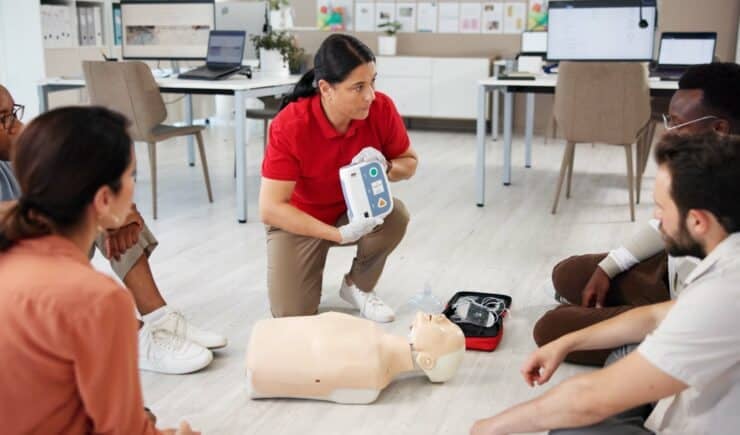Some say converting instructor-led training (ILT) into a virtual format is the future of learning. While virtual classrooms offer convenience and flexibility, they do not necessarily capture the deep impact of a well-delivered, human-led session. When it comes to training on critical tasks, nothing beats the tailored, interactive experience of traditional ILT—and modern tools can make it more scalable and cost-effective than ever.
The Unique Value of Instructor-Led Training
Real-Time Interaction and Immediate Feedback
One of ILT’s most powerful advantages is the ability to offer immediate, personalized feedback. In a live, instructor-led session, learners can ask questions, engage in hands-on practice, and receive clarifications on complex topics as they arise. This real-time dialogue not only reinforces learning but also builds confidence in handling critical tasks. Studies have shown that ILT environments achieve higher learner engagement and retention compared to formats that rely on self-paced content alone .
Personalization and Adaptive Learning
Every learner comes with unique experiences and needs. In an ILT setting, instructors can gauge understanding through nonverbal cues and interactive discussions—adjusting the pace and focus as necessary. This kind of personalized instruction is crucial when teaching high-stakes skills, where a one-size-fits-all approach simply will not do. The ability to tailor the learning journey is a key reason why many organizations continue to invest heavily in ILT for critical training.
Enhanced Engagement and Collaboration
ILT naturally fosters a dynamic learning environment. Whether through small group activities, hands-on demonstrations, or interactive Q&A sessions, learners benefit from both instructor expertise and peer-to-peer collaboration. This environment cultivates a sense of accountability and community—elements that are difficult to replicate in purely virtual or self-paced formats. In-person or live ILT settings help create a learning culture that drives higher performance on the job.
Rethinking the “Virtual-Only” Approach
While converting ILT to a virtual classroom might seem like an attractive way to save on travel and logistical costs, it often overlooks the intrinsic value of face-to-face interaction. Virtual sessions can dilute the impact of nonverbal communication, subtle cues, and spontaneous discussion—all critical for deep learning. When the focus shifts solely to digitizing content, the human element—the very element that drives engagement, adaptation, and meaningful learning—can be lost.
Moreover, expecting a virtual session to mirror an entire day of face-to-face instruction may not only overwhelm learners but can also lead to “virtual fatigue.” Instead of simply shifting ILT online, organizations should consider how best to preserve its core strengths. A blended approach might work for some topics, but for critical tasks where real-time feedback and hands-on practice are indispensable, maintaining the integrity of ILT is essential.
Leveraging Technology to Optimize ILT
A new breed of learning technology is changing how ILT is managed. Training management systems, like Administrate, offer a smarter way to manage ILT without sacrificing its proven benefits. By automating scheduling, resource management, and reporting, such platforms lower overhead and reduce administrative burdens—making ILT more cost-effective and scalable. Here’s how:
- Automated Scheduling and Resource Allocation: Administrate streamlines the logistical aspects of ILT. Instead of manually coordinating instructor availability, room bookings, and equipment, organizations can use automated tools to optimize resource utilization, ensuring high occupancy rates and minimizing wasted time.
- Real-Time Reporting and Data Insights: Advanced reporting capabilities provide actionable insights into training performance and resource efficiency. This data-driven approach helps refine ILT programs over time, ensuring they remain aligned with business objectives.
- Maintaining High Engagement Without Compromise: By keeping the instructor present and facilitating live, interactive sessions, ILT continues to deliver on its promise of personalized learning. Administrate’s integrated tools allow for both flexibility and structure—enabling training teams to focus on content and engagement rather than administrative hassles.
For organizations training on critical tasks, the traditional ILT model remains the gold standard. Its inherent advantages—immediate feedback, personalized instruction, and dynamic engagement—are essential for mastering complex skills. Rather than converting ILT entirely to a virtual format, companies should invest in modern management solutions that enhance its efficiency and scalability. With platforms like Administrate, it is possible to reduce costs and overhead while preserving the invaluable human connection that makes ILT so effective.
In a world of ever-evolving technology, the key is not to replace instructor-led training with virtual alternatives but to optimize ILT with the right tools. That way, organizations can ensure their workforce is both highly skilled and well-prepared to meet the challenges of today’s critical tasks.





